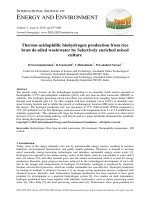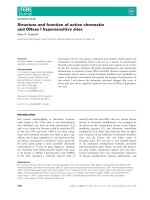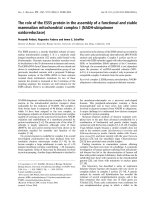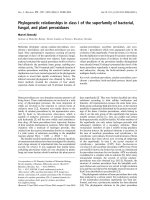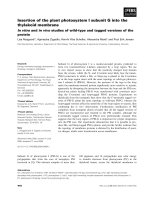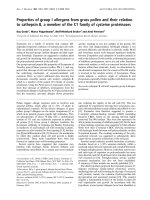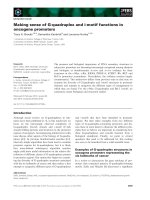Extraction of î± tocopherol and î³ oryzanol from rice bran
Bạn đang xem bản rút gọn của tài liệu. Xem và tải ngay bản đầy đủ của tài liệu tại đây (316.2 KB, 8 trang )
LWT 41 (2008) 1417–1424
Extraction of a-tocopherol and g-oryzanol from rice bran
Photchanathip Imsanguan
a
, Amorn Roaysubtawee
a
, Ratsuda Borirak
a
,
Suwassa Pongamphai
a,Ã
, Supaporn Douglas
a
, Peter L. Douglas
b
a
Department of Chemical Engineering, King Mongkut’s University of Technology, Thonburi, Bangkok 10140, Thailand
b
Department of Chemical Engineering, University of Waterloo, Waterloo, Ont., Canada N2L 3G1
Received 15 May 2007; received in revised form 31 August 2007; accepted 31 August 2007
Abstract
The aim of this research was to study the effect of operating mode (continuous versus batch+continuous), temperature, pressure and
solvent on a-tocopherol and g-oryzanol extraction from rice bran (Oryza sativa Linn.) and compare the efficiency of three extraction
methods: SC-CO
2
extraction, solvent extraction and soxhlet extraction. Three sets of experiments were performed. First, extraction
using SC-CO
2
was performed over a range of temperatures and pressures (45–65 1C and at 38 and 48 MPa), and at a CO
2
flow rate of
0.45 mL/min. The results showed that the best conditions for a-tocopherol extraction were 55 1C, 48 MPa in the batch+continuous
mode. For g-oryzanol, the best conditions were 65 1C, 48 MPa and in the continuous mode. In the second set of experiments, solvent
extraction using hexane and ethanol at 32 and 55–60 1C was studied. The results showed that none of the solvents could extract
a-tocopherol; however, ethanol at 55–60 1C was suitable for g-oryzanol extraction. Finally, soxhlet extraction experiments using hexane
for a-tocopherol and ethanol for g-oryzanol were also performed. In summary, SC-CO
2
was found to be the best solvent for extracting
both a-tocopherol and g-oryzanol from rice bran, because of its higher yields and extraction rate.
r 2007 Swiss Society of Food Science and Technology. Published by Elsevier Ltd. All rights reserved.
Keywords: Rice bran; a-Tocopherol; g-Oryzanol; Supercritical carbon dioxide; Solvent extraction
1. Introduction
Rice (Oryza sativa Linn.) production is a significant crop
in Thailand resulting in significant amounts of rice bran
waste. Rice bran contains many valuable substances
such as vitamin E (a-tocopherol and tocotrienol) and
g-oryzanol. The major component of vitamin E in rice bran
is a-tocopherol which is an antioxidant and can lower the
risk of cancer formation and coronary heart diseases
(Zhimin, Na, & Samuel, 2001), it is also reported to
prevent Alzheimer’s disease and allergies (Mervyn, 1994).
g-Oryzanol is a mixture of 10 ferulate esters of triterpene
alcohol (Zhimin et al., 2001) and can be used to reduce
blood cholesterol levels, treat nerve imbalance, as well as
an antiox idant and preservative (Murase & Iishima, 1963;
Rong, Ausman, & Nicholosi, 1994; Sasaki et al., 1990). The
major components of g-oryzanol in rice bran are cycloar-
tenyl ferulate, 24-methylene cycloartanyl ferulate and
campestanyl ferulate (Zhimin et al., 2001). Since they are
so abundant in rice bran, this research focused on the
extraction of a-tocopherol and g-oryzanol (cycloartenyl
ferulate, 24-methylene cycloartanyl ferulate and campesta-
nyl ferulate) from rice bran. The chemical structures
of a-tocopherol and g-oryzanol are shown in Figs. 1 and
2, respectively. Currently, a-tocopherol and g-oryzanol
are extracted from various sources such as wheat germ
(Ge, Ni, Yan, Chen, & Cai, 2002), rice by-product
(Perretti, Miniati, Montanari, & Fantozzi, 2003) using
supercritical carbon dioxide (SC-CO
2
), and rice bran oil
(Noppamas, 2002) using solvent extraction. The authors
can find no reports in the literature describing the direct
extraction of a-tocopherol or g-oryzanol from rice bran
using supercritical carb on dioxide. The literature does
however contain studies on the extraction of these
substances from rice bran oil (Noppamas, 2002). This then
leads to the motivation for this research. Carbon dioxide is
the most commonly used supercritical solvent, because it
ARTICLE IN P RESS
www.elsevier.com/locate/lwt
0023-6438/$34.00 r 2007 Swiss Society of Food Science and Technology. Published by Elsevier Ltd. All rights reserved.
doi:10.1016/j.lwt.2007.08.028
Ã
Corresponding author. Tel.: +66 24709221x208; fax: +66 24283534.
E-mail address: (S. Pongamphai).
has a relatively low critical temperature and pressure
(31.1 1C and 7.39 MPa), non-toxic, non-flammable, non-
corrosive, inert and inexpensive.
The most suitable extraction methods for the extrac-
tion of vitamin E (a-tocopherol) and g-oryzanol
(cycloartenyl ferulate, 24-methylene cycloartanyl ferulate
and campestanyl ferulate) from rice bran were studied and
the extraction efficiency and operating conditions were
determined.
2. Materials and methods
2.1. Materials
Bran from Suphanburi rice, which was grown at
Chacherngsow, Thailand, was used in this work. Carbon
dioxide (99.95% purity) was supplied by Thai Industrial
Gases (TIG), Thailand. Methanol, acetonitrile, hexane and
ethanol used in this work are of HPLC grade and were
ARTICLE IN P RESS
Fig. 1. The chemical structure of a-tocopherol (Noppamas, 2002).
Fig. 2. The chemical structures of g-oryzanol (Zhimin & Samuel, 1999).
P. Imsanguan et al. / LWT - Food Science and Technology 41 (2008) 1417–14241418
procured from Merck Ltd., Thailand. a-Tocopherol and g-
oryzanol standards were obtained from Sigma Chemical
Co., USA and Tsuno, Japan, respectively.
2.2. Rice bran mean composition
Rice bran was analyzed for particle size, moisture and oil
content. The particle size was measured using a Taylor
sieve. The moisture content was determined using oven
drying at 110 1C for 2 h and the oil content was measured
using soxhlet extraction with hexane for 24 h (AOAC,
1995).
2.3. Extraction of a-tocopherol and g-oryzanol from rice
bran using SC-CO
2
SC-CO
2
extraction experiments were carried out in an
ISCO Model SFX
TM
3560 laboratory extractor shown in
Fig. 3. SC-CO
2
extraction was to study the effect of
operation mode (continuous versus batch+continuous),
pressure (38 and 48 MPa) and temperature (45–65 1C).
2.3.1. Effect of operating mode
2.3.1.1. Continuous mode. A 0.5 g of rice bran was placed
in the extraction vessel. The flow rate of CO
2
was set at
0.45 mL/min and allowed to flow continuously through
the extraction vessel for 7 h at a temperature of 55 1C
and a pressure of 48 MPa. The extract was analyzed
using a Waters Corporation, Model #600-486-717 high-
performance liquid chromatograph (HPLC). HPLC ana-
lysis was performed using symmetry C-18 column
(150 mm  3.9 mm i.d.) with mobile phase acetonitrile:-
methanol (90:10, v/v), flow rate of 1.5 mL/min and UV
detector of 295 nm.
2.3.1.2. Batch+continuous mode. Rice bran was placed in
the extraction vessel and exposed to SC-CO
2
at 55 1C and
48 MPa for 1 h and then CO
2
was allowed to flow through
the sample at a flow rate of 0.45 mL/min for 6 h.
2.4. Extraction of a-tocopherol and g-oryzanol from rice
bran using solvent extraction
A 1 g sample of rice bran was extracted using 100 mL of
hexane at a rotating speed of 200 rpm and a temperature
varying from 32 1C to about 55–60 1C for 24 h. The extract
was analyzed using an HPLC. The hexane solvent was
replaced with ethanol and the remainder of procedure and
conditions are all the same as before.
2.5. Extraction of a-tocopherol and g-oryzanol from rice
bran using vacuum soxhlet extraction
A 3 g sample of rice bran was extracted in a soxhlet
apparatus with 300 mL of hexane at temperatures varying
from 65 to 70 1C and pressures varying from 500 to
550 mmHg for 24 h. The extract was analyzed using an
HPLC. The hexane solvent was then replaced with ethanol
and the remainder of the procedure and conditions are all
the same as before.
3. Results and discussion
3.1. Rice bran mean composition
Bran from Supha nburi rice (O. sativa Linn.) was used in
this research. Moisture and fat/oil content of rice bran were
found to be 14.01% and 19.08% (w/w), respectively. The
ARTICLE IN P RESS
Fig. 3. ISCO Model SFX
TM
3560 supercritical CO
2
extractor.
P. Imsanguan et al. / LWT - Food Science and Technology 41 (2008) 1417–1424 1419
majority of rice bran particles were found to be 297–595 mm
in size as shown in Table 1.
3.2. SC-CO
2
extraction
3.2.1. Effect of operating mode
A comparison of two methods of SC-CO
2
extraction, (i)
continuous mode (ii) batch+continuous mode, is shown in
Figs. 4 and 5 for a-tocopherol and g-oryzanol, respectively.
The extraction was performed at 55 1C, 48 MPa and a CO
2
flow rate of 0.45 mL/min. The results show that the
extraction of a-tocopherol reached a maximum of both
continuous mode and batch+continuous mode operations
after which no additional extraction was observed; the
average extraction rate was 24.80 mg/kg (dry basis )/h
and 31.83 mg/kg (dry basis)/h, respectively and the extrac-
tion rate of g-oryzanol was 2322.79 and 2464.73 mg/kg/h,
respectively. Fig. 4 shows that batch+continuous mode
results in higher extraction rates than continuous
mode. a-Tocopherol is found in a stable matrix form in
rice bran, so continuous mode is inadequate for high
a-tocopherol extraction. Under batch+continuous mode,
CO
2
was confined inside extraction vessel for 1 h, thereby
increasing the CO
2
penetration into rice bran and increas-
ing extraction resulting in an increase in the a-tocopherol
extraction. On the other hand, Fig. 5 shows a lower
g-oryzanol extraction rate when batch+continuous mode
was used.
3.2.2. Effect of pressure
SC-CO
2
extraction was carried out at a constant
temperature of 65 1C, a carbon dioxide flow rate of
0.45 mL/min and a pressure varying from 38 to 48 MPa.
The extraction results for a-tocopherol and g-oryzanol are
shown in Figs. 6 and 7, respectively. Both figures indicate
that when the pressure was increased, the extraction rate
and yields increased. This effect is expected since an
increase in the pressure increases the density and solvent
ability of supercritical fluid thereby allowing it to dissolve
more solute.
ARTICLE IN P RESS
Table 1
Size distribution of rice bran particles
Particle size Rice bran (%)
Mesh mm
418 41000 8.7
18–30 595–1000 25.4
30–50 297–595 36.2
50–80 177–297 26.7
80–100 149–177 2.8
o100 o149 0.2
012 6
time (h)
0
20
40
60
80
100
120
140
alpha-tocopherol (mg/kg dry basis)
754
3
Fig. 4. Effect of operating mode on a-tocopherol extraction using SC-
CO
2
(T ¼ 55 1C, P ¼ 48 MPa, CO
2
flow rate ¼ 0.45 mL/min): (’)
continuous and (m) batch+continuous.
047
time (h)
0
2000
4000
6000
8000
10000
12000
gamma-oryzanol (mg/kg dry basis)
65321
Fig. 5. Effect of operating mode on g-oryzanol extraction using SC-CO
2
(T ¼ 55 1C, P ¼ 48 MPa, CO
2
flow rate ¼ 0.45 mL/min): (’) continuous
and (m) batch+continuous.
01 5
time (h)
0
20
40
60
80
100
120
140
alpha-tocopherol (mg/kg dry basis)
76432
Fig. 6. Effect of pressure on a-tocopherol extraction using SC-CO
2
(T ¼ 65 1C, CO
2
flow rate ¼ 0.45 mL/min): (’) 38 MPa and (m) 48 MPa.
P. Imsanguan et al. / LWT - Food Science and Technology 41 (2008) 1417–14241420
3.2.3. Effect of temperature
The effect of temperature on the extraction was studied
at a constant pressure of 48 MPa, using a CO
2
flow rate of
0.45 mL/min and at temperatures from 45 to 65 1C. The
results of a-tocopherol and g-oryzanol extraction are
shown in Figs. 8 and 9, respectively. These figures indicate
that increasing extraction temperature results in increase
extraction rates. This effect is also expected since increasing
the temperature decreases the viscosity and increases the
diffusivity resulting in an increased extraction rate.
Based on the range of experimental conditions, the best
conditions for a-tocopherol extraction using supercritical
carbon dioxide were found to be 48 MPa, 55 1C, CO
2
flow
rate of 0.45 mL/min with batch+c ontinuous mode and for
g-oryzanol extraction were found to be 48 MPa, 65 1C, CO
2
flow rate of 0.45 mL/min with continuous mode. The
extraction yields of a-tocopherol and g-oryzanol at these
conditions were 127.33 and 11,371.79 mg/kg (dry basis),
respectively.
Fig. 10 shows an HPLC chromatogram of the extract;
retention times of a-tocopherol and 3 of the 10 components
of g-oryzanol (cycloartenyl ferulate, 24-methylene cycloar-
tanyl ferulate and campestanyl ferulate) were identified and
found to be 10.52, 21.58, 24.61 and 30.18 min, respectively.
The area under a particular peak in the chromatogram
indicates the amount of that particular component in the
rice bran extract.
3.3. Solvent extraction
The solvent extraction experiments were carried out at
atmospheric pressure and at various temperatures. Solvent
extraction experiments showed neither ethanol nor hexane
could extract a-tocopherol. The results showed that this is
because a-tocopherol is in a matrix form in rice bran, so
extraction at low pressure (i.e. atmospheric pressure) is
inadequate for a-tocopherol extraction, because this
pressure cannot eliminate the interferences from other
molecules such as proteins and carbohydrates, that are
non-soluble in organic solvents (Ruperez, Martın, Herrera,
& Barbas, 2001). Perhap s at elevated pressures and longer
extraction times a-tocopherol might be extracted from rice
bran. The results of solvent extraction of g-oryzanol using
hexane are shown in Fig. 11. This figure shows that
increasing temperatur e increases the quantity of g-oryzanol
extracted. Increasing temperature decreases the viscosity
and increases the diffusivity of the solvent resulting in
increasing extraction rate and yield. In this work, the
highest extraction yield of g-oryzanol was found to be
7349.25 mg/kg (dry basis) at temperatures between 55 and
60 1C. The effect of solvent type on the extracti on was
ARTICLE IN P RESS
0
time (h)
0
2000
4000
6000
8000
10000
12000
gamma-oryzanol (mg/kg dry basis)
7654321
Fig. 7. Effect of pressure on g-oryzanol extraction using SC-CO
2
(T ¼ 65 1C, CO
2
flow rate ¼ 0.45 mL/min): (’) 38 MPa and (m) 48 MPa.
012 6
time (h)
0
20
40
60
80
100
120
140
alpha-tocopherol (mg/kg dry basis)
5743
Fig. 8. Effect of temperature on a-tocopherol extraction using SC-CO
2
(P ¼ 48 MPa, CO
2
flow rate ¼ 0.45 mL/min): (K)451C, (m)551C and
(’)651C.
01
time (h)
0
2000
4000
6000
8000
10000
12000
gamma-oryzanol (mg/kg dry basis)
765432
Fig. 9. Effect of temperature on g-oryzanol extraction using SC-CO
2
(P ¼ 48 MPa, CO
2
flow rate ¼ 0.45 mL/min): (K)451C, (m)551C and
(’)651C.
P. Imsanguan et al. / LWT - Food Science and Technology 41 (2008) 1417–1424 1421
carried out at atmospheric pressure and temperature
of 55–60 1C. Fig. 12 shows the solvent extraction of
g-oryzanol using bot h ethanol and hexane. Ethanol was
found to be a better solvent than hexane. This is because
g-oryzanol, which consists of triterpene alcohol or sterols
and fururic acid, is a polar molecule (Zhimin & Samuel,
1999), so it is easily dissol ved in ethanol, which is also
a polar molecule; extraction yield was 9414.02 mg/kg
(dry basis).
3.4. Vacuum soxhlet extraction
The effect of solvent type on the vacuum soxhlet
extraction was carried out at pressures of 500–550 mmHg
and temperatures of 65–70 1C. The results showed that
hexane and ethanol were the best solvents for a-tocopherol
and g-oryzanol extraction, respectively. This is because
hexane and a-tocopherol are non-polar molecules, wher eas
ethanol and g-oryzanol are polar molecules. Extraction
yields of a-tocopherol and g-oryzanol were found to be
172.23 and 9808.79 mg/kg (dry basis), respectively. More-
over, the quantity of both substances using the vacuum
soxhlet extraction was higher than that achieved using the
solvent extraction. The reasons being that the extraction
temperature of the soxhlet extraction was higher than the
solvent extraction, and the solvent used in soxhlet
extraction can be evaporated and condensed in the same
way as the steam distillation, so efficiency of the soxhlet
extraction is higher than the solvent extraction (Pattira,
Krisda, & Kittipong, 2003).
3.5. Extraction rate
Figs. 4–9, 11 and 12 show that extraction rate is
increasing in the beginning of extraction, since there
is a lot of concentration gradient of substances in bulk
fluid and interior of rice bran. The extraction rate then
ARTICLE IN P RESS
Fig. 10. Chromatogram of the rice bran extract using SC-CO
2
(P ¼ 48 MPa, T ¼ 65 1C).
04812162024
time (h)
0
2000
4000
6000
8000
10000
12000
gamma-oryzanol (mg/kg dry basis)
Fig. 12. Effect of solvent type on g-oryzanol extraction: (m) hexane and
(’) ethanol.
0481216
20
24
time (h)
0
2000
4000
6000
8000
10000
12000
gamma-oryzanol (mg/kg dry basis)
Fig. 11. Effect of temperature on g-oryzanol extraction using hexane: (m)
32 1C and (’) 55–60 1C.
P. Imsanguan et al. / LWT - Food Science and Technology 41 (2008) 1417–14241422
continually decreases due to the decreasing of concentra-
tion gradient of the solute in the solvent. Finally, the
extraction process approaches equilibrium.
3.6. Extraction efficiency
The comparison of three extraction methods, SC-CO
2
,
solvent and soxhlet extra ction, is shown in Figs. 13 and 14
for a-tocopherol and g-oryzanol, respectively. The extrac-
tion efficiency of a-tocopherol for SC-CO
2
and solvent
extraction were 73.93% and 0%, respectively, as compared
to soxhlet extraction. For g-oryzanol, extraction yield of
SC-CO
2
extraction is greater than the soxhlet extraction,
because soxhlet extraction time and temperature were
higher than that of SC-CO
2
extraction, so some g-oryzanol
was degraded. Both figures indicated that SC-CO
2
extrac-
tion resulted in higher extraction yields, lower extraction
time and avoided degradation of substances.
4. Conclusions
The results indicated that the extraction of a-tocopherol
and g-oryzanol from rice bran is successfully performed using
SC-CO
2
. The extraction yields of a-tocoph erol and g-o ryzanol
depend on the pressure and temp erature during extraction.
The best conditions for a-tocoph erol extraction were pressure
of 48 MPa, temperature of 55 1C and batch +continuous
mode. Extraction yield was 127.33 mg/kg (dry basis). For
g-oryzanol extraction, the best condition s w ere p ressure o f
48 MPa, temperature of 65 1C in the continuous mode.
Extraction yield was 11,371.79 mg/kg (dry basis).
Neither ethanol nor hexane could extract a-tocopherol at
atmospheric pressure but ethanol at 55–60 1C was found to
be best for extracting g-oryzanol. For soxhlet extraction,
hexane and ethanol were the best solvent for a-tocopherol
and g-oryzanol extraction, respectively.
Based on a comparison of three extraction methods
(SC-CO
2
, solvent extraction and s oxhlet), it was concluded
that SC-CO
2
extraction was the best extraction method for
a-tocopherol and g-oryzanol extraction from rice bran.
Extraction using SC-CO
2
results in h igh yields a nd the h ighest
extraction rates u sing a non-toxic solvent, C O
2
. Although a
greater y ield of a-tocopherol r esults from soxhlet extraction
with hexane than SC-CO
2
, the extraction rate is significantly
higher when using SC-CO
2
than hexane (31.83 mg/kg/h with
SC-CO
2
compared to 7.18 mg/kg/h with soxhlet). Since the
SC-CO
2
extraction ti me was m uch l ower than the soxhlet
extraction time (4 h compared to 24 h ) at similar temperatures
the possibility of thermal degradation is greatly reduced.
Acknowledgment
The authors gratefully acknowledge the financial sup-
port from the Thailand Research Fund (TRF) through the
Royal Golden Jubilee Ph.D. Program (1.C.KT/47/G.1).
References
AOAC. (1995) (16th ed.). Official methods of analysis, Vol. 41.
Washington, DC: Association of Official Analytical Chemists.
Ge, Y., Ni, Y., Yan, H., Chen, Y., & Cai, T. (2002). Optimization of the
supercritical fluid extraction of natural vitamin E from wheat germ
using response surface methodology. Journal of Food Science, 67(1),
239–243.
Mervyn, L. (1994). The vitamins explained simply. Bangkok: Smith
(pp. 131–139).
Murase, Y., & Iishima, H. (1963). Clinical studies of oral administration
of gamma-oryzanol on climacteric complaints and its syndrome.
Obstetrics and Gynecological Practice, 12, 147–149.
Noppamas, M. (2002). The investigation of g-oryzanol and vitamin E
content in Thai rice varieties (pp. 11–67). Master of Science,
Department of Bioresources and Technology, King Mongkut’s
University of Technology, Thonburi.
Pattira, P., Krisda, K., & Kittipong, R. (2003). Supercritical carbon
dioxide extraction of vitamin E from oil palm leaves (pp. 18–20).
ARTICLE IN P RESS
sc-co
2
(6 h) solvent (ethanol 24 h) soxhlet (ethanol 24 h)
extraction method
0
2000
4000
6000
8000
10000
12000
gamma-oryzanol (mg/kg dry basis)
Fig. 14. Comparison of extraction methods (SC-CO
2
extraction, solvent
extraction using ethanol and soxhlet extraction using ethanol) for g-
oryzanol extraction.
sc-co
2
(4 h) solvent (24 h) soxhlet (hexane 24 h)
extraction method
0
20
40
60
80
100
120
140
160
180
alpha-tocopherol (mg/kg dry basis)
Fig. 13. Comparison of extraction methods (SC-CO
2
extraction, solvent
extraction and soxhlet extraction using hexane) for a-tocopherol extrac-
tion.
P. Imsanguan et al. / LWT - Food Science and Technology 41 (2008) 1417–1424 1423
Bachelor of Engineering, Department of Chemical Engineering, King
Mongkut’s University of Technology, Thonburi.
Perretti, G., Miniati, E., Montanari, L., & Fantozzi, P. (2003). Improving
the value of rice by-products by SFE. Journal of Supercritical Fluids,
26, 63–71.
Rong, N., Ausman, L. M., & Nicholosi, R. J. (1994). Rice bran oil
decreases plasma LDL cholesterol by inhibitory dietary cholesterol
absorption. The FASEB Journal: Official Publication of the Federation
of American Societies for Experimental Biology, 8, 303–309.
Ruperez, F. J., Martın, D., Herrera, E., & Barbas, C. (2001). Chromato-
graphic analysis of a-tocopherol and related compounds in various
matrices. Journal of Chromatography A, 935, 45–69.
Sasaki, J., Takada, Y., Kusuda, M., Tanabe, Y., Matsunaga, A., &
Arakawa, K. (1990). Effects of g-oryzanol on serum lipids and
apolipoproteins in dyslipidemic schizophrenics receiving major tran-
quilizero. Clinical Therapeutics, 12, 263–268.
Zhimin, X., Na, H., & Samuel, G. J. (2001). Antioxidant activity of
tocopherols, tocotrienols, and g-oryzanol components from rice bran
against cholesterol oxidation accelerated by 2,2
0
-azobis(2-methylpro-
pionamidine) dihydrochloride. Journal of Agriculture and Food
Chemistry, 49, 2077–2081.
Zhimin, X., & Samuel, G. J. (1999). Purification and identification of
components of g-oryzanol in rice bran oil. Journal of Agriculture and
Food Chemistry, 47, 2724–2728.
ARTICLE IN P RESS
P. Imsanguan et al. / LWT - Food Science and Technology 41 (2008) 1417–14241424
